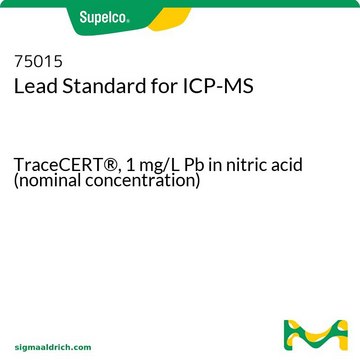180173
Sulfure de carbone
ACS reagent, ≥99.9%
About This Item
Produits recommandés
Qualité
ACS reagent
Densité de vapeur
2.67 (vs air)
Pression de vapeur
5.83 psi
Essai
≥99.9%
Forme
liquid
Température d'inflammation spontanée
212 °F
Limite d'explosivité
50 %
dilution
(for analytical testing)
Impuretés
H2S, passes test (lim. ~1.5 ppm)
SO2, passes test (lim ~2.5 ppm)
≤0.05% water
Résidus d'évap.
≤0.002%
Couleur
APHA: ≤10
Indice de réfraction
n20/D 1.627 (lit.)
pb
46 °C (lit.)
Pf
−112-−111 °C (lit.)
Densité
1.266 g/mL at 25 °C (lit.)
Chaîne SMILES
S=C=S
InChI
1S/CS2/c2-1-3
Clé InChI
QGJOPFRUJISHPQ-UHFFFAOYSA-N
Vous recherchez des produits similaires ? Visite Guide de comparaison des produits
Catégories apparentées
Description générale
Application
It may be used in the preparation of dibenzyl trithiocarbonate, a RAFT (Reversible Addition-Fragmentation Transfer) chain-transfer agent (CTA). It may be employed as a solvent in the preparation of benzyl chlorodithioformate.
Conditionnement
Produit(s) apparenté(s)
Mention d'avertissement
Danger
Mentions de danger
Classification des risques
Acute Tox. 4 Inhalation - Eye Irrit. 2 - Flam. Liq. 2 - Repr. 2 - Skin Irrit. 2 - STOT RE 1
Organes cibles
Peripheral nervous system,Central nervous system,Cardio-vascular system,Eyes
Code de la classe de stockage
3 - Flammable liquids
Classe de danger pour l'eau (WGK)
WGK 2
Point d'éclair (°F)
-22.0 °F - closed cup
Point d'éclair (°C)
-30 °C - closed cup
Faites votre choix parmi les versions les plus récentes :
Déjà en possession de ce produit ?
Retrouvez la documentation relative aux produits que vous avez récemment achetés dans la Bibliothèque de documents.
Notre équipe de scientifiques dispose d'une expérience dans tous les secteurs de la recherche, notamment en sciences de la vie, science des matériaux, synthèse chimique, chromatographie, analyse et dans de nombreux autres domaines..
Contacter notre Service technique







